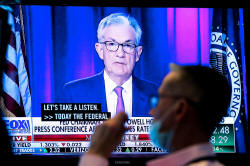Investors look ahead to rate hikes with Fed tapering plan all but
certain
 Send a link to a friend
Send a link to a friend
 [September 23, 2021] By
David Randall [September 23, 2021] By
David Randall
NEW YORK (Reuters) - Investors are
grappling with how an unwind of the Federal Reserve’s easy money
policies could affect asset prices, after the central bank signaled that
a taper of its bond-buying program was closer than ever and suggested it
may raise rates at a faster-than-expected pace.
In what some described as a hawkish tilt, the Federal Reserve on
Wednesday cleared the way to begin reducing its monthly bond purchases
as soon as November, and nine of 18 U.S. central bank policymakers
projected borrowing costs will need to rise in 2022.
Fed Chairman Jerome Powell said the U.S. central bank could conclude its
tapering process around the middle of next year, as long as the recovery
remains on track.
The focus on rate increases comes as investors gauge how markets will
respond to an unwind of the central bank’s $120 billion per month
bond-buying program, which has helped the S&P 500 double from its March
2020 lows.

Though many had expected the central bank to begin its unwind before the
year was up, some investors said the projection for rate increases may
spur worries over whether the Fed risks tightening monetary policy at a
time when the economy could be significantly weaker than it is today,
potentially undercutting the case for stocks and other comparatively
risky assets.
"With this hawkish move, the Fed risks tightening policy into a
slow-growth backdrop," said Emily Roland, co-chief investment strategist
at John Hancock Investment Management.
Stocks held onto their gains after the Fed’s statement, with the S&P 500
closing up nearly 1%.
In Treasury markets, the gap between five-year notes and 30-year bonds
fell below 100 basis points after the Fed policy statement to the lowest
level since July 2020. A narrower gap could indicate factors like
economic uncertainty, easing inflation concerns and anticipation of
tighter monetary policy.
“The rates market interpreted Fed communications as hawkish,” analysts
at BoFA Global Research said in a note. “The more hawkish Fed is a key
ingredient for our higher rates view into year-end.”
The Fed funds market fully priced in a rate hike by January 2023 after
the statement, moving projected rate increases forward by a month.
[to top of second column] |

A screen displays a statement by Federal Reserve Chair Jerome Powell
following the U.S. Federal Reserve's announcement as a trader works
on the trading floor of the New York Stock Exchange (NYSE) in New
York City, U.S., September 22, 2021. REUTERS/Brendan McDermid

Analysts at TD Securities expect the central bank to reduce its asset purchases
by $15 billion a month starting in November, helping push up yields and
strengthen the dollar, they said in a report.
The U.S. currency's trajectory is important for investors as it impacts
everything from commodity prices to corporate earnings. Higher yields make
dollar-denominated assets more attractive to income-seeking investors. The
greenback was up 0.23% against a basket of its peers late Wednesday.
"Once the dust settles it seems that there are enough hawkish signals to keep
the dollar biased higher, as the market pencils in a sooner-than-expected rate
hike," said Joe Manimbo, senior market analyst at Western Union Business
Solutions.
Others were sanguine on the Fed’s outlook, saying the more hawkish view was a
reflection of the economy’s strength in the face of a COVID-19 resurgence.
Markets are likely to remain more focused on the inference that additional rate
hikes in 2022 and 2023 would suggest a strengthening economy than on the Fed's
tapering plan, said Mark Freeman, chief investment officer at Socorro Asset
Management.
"Powell clarified repeatedly ... that the criteria for tapering is very
different than criteria for raising rates, which is much higher" and will have
more of a market impact, he said.
Rick Rieder, chief investment officer of global fixed income at BlackRock, said
in a note that robust demand for Treasuries would likely minimize the impact of
the Fed’s unwind.

“With the demand for income and financial assets that we’re seeing..., the
modest tapering likely to be seen from the Fed is not consequential for
markets,” he said.
(Reporting by David Randall; Additional reporting by Sinead Carew and Gertrude
Chavez-Dreyfuss; Editing by Ira Iosebashvili and Leslie Adler)
[© 2021 Thomson Reuters. All rights
reserved.] Copyright 2021 Reuters. All rights reserved. This material may not be published,
broadcast, rewritten or redistributed.
Thompson Reuters is solely responsible for this content. |